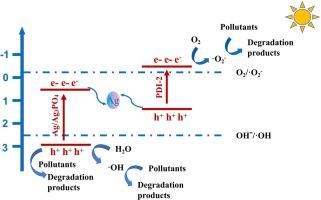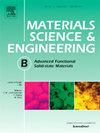Study on the mechanism of photocatalytic activity enhancement of Ag/Ag3PO4/PDI-2 supramolecular Z-scheme heterojunction photocatalyst
IF 3.9
3区 材料科学
Q2 MATERIALS SCIENCE, MULTIDISCIPLINARY
Materials Science and Engineering B-advanced Functional Solid-state Materials
Pub Date : 2024-11-17
DOI:10.1016/j.mseb.2024.117845
引用次数: 0
Abstract
In this paper, a new supramolecular Z-scheme heterojunction photocatalyst, designated as Ag/Ag3PO4/Perylene diimide organic molecules after secondary acid-base self-assembly (PDI-2), was synthesized through precipitation and photoreduction techniques. Ag/Ag3PO4/60 %PDI-2 (APP-6) exhibited the best photocatalytic activity due to the synergistic effect of Z-scheme heterojunction and surface plasmon resonance (SPR) effect of Ag nanoparticles (Ag NPs). Under visible light (λ > 420 nm), the degradation efficiency of APP-6 for Rhodamine B (RhB) and Bisphenol A (BPA) was 99.7 % and 90.7 %, respectively. Additionally, PDI-2 was transformed into smaller nanoclusters, which increased the specific surface area of the photocatalyst, and reduced the charge transport distance. Moreover, APP-6 exhibited the smallest electrochemical impedance, the largest photocurrent, the smallest fluorescence lifetime. Free radical trapping experiments showed that •O2− was the main reactive group and a possible photocatalytic mechanism was proposed by combining the Ultraviolet–visible diffuse reflectance spectrophotometer (UV–vis DRS) and the Mott-Schottky plots.

Ag/Ag3PO4/PDI-2 超分子 Z 型异质结光催化剂光催化活性增强机理研究
本文通过沉淀和光还原技术合成了一种新型超分子 Z 型异质结光催化剂,命名为 Ag/Ag3PO4/Perylene diimide organic molecules after secondary acid-base self-assembly (PDI-2)。由于 Z 型异质结的协同效应和银纳米粒子(Ag NPs)的表面等离子体共振(SPR)效应,Ag/Ag3PO4/60 %PDI-2 (APP-6)表现出最佳的光催化活性。在可见光(λ > 420 nm)条件下,APP-6对罗丹明B(RhB)和双酚A(BPA)的降解效率分别为99.7%和90.7%。此外,PDI-2 转化为更小的纳米团簇,增加了光催化剂的比表面积,并缩短了电荷传输距离。此外,APP-6 的电化学阻抗最小、光电流最大、荧光寿命最短。自由基捕获实验表明 -O2- 是主要的反应基团,并结合紫外可见光漫反射分光光度计(UV-vis DRS)和 Mott-Schottky 图提出了可能的光催化机理。
本文章由计算机程序翻译,如有差异,请以英文原文为准。
求助全文
约1分钟内获得全文
求助全文
来源期刊
CiteScore
5.60
自引率
2.80%
发文量
481
审稿时长
3.5 months
期刊介绍:
The journal provides an international medium for the publication of theoretical and experimental studies and reviews related to the electronic, electrochemical, ionic, magnetic, optical, and biosensing properties of solid state materials in bulk, thin film and particulate forms. Papers dealing with synthesis, processing, characterization, structure, physical properties and computational aspects of nano-crystalline, crystalline, amorphous and glassy forms of ceramics, semiconductors, layered insertion compounds, low-dimensional compounds and systems, fast-ion conductors, polymers and dielectrics are viewed as suitable for publication. Articles focused on nano-structured aspects of these advanced solid-state materials will also be considered suitable.

 求助内容:
求助内容: 应助结果提醒方式:
应助结果提醒方式:


